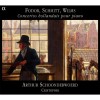传记
Georg Adam Joseph Schmitt (baptised on 18 March 1734 in Gernsheim, Germany, died on 28 May 1791 in Amsterdam) was a German/Dutch composer, conductor, music director, publisher, music theorist and pedagogue. He is also known as "The Dutch Haydn".[1]
Joseph Schmitt was a student of Carl Friedrich Abel, who was a student of J.S. Bach and a mentor of Mozart, and probably also had close contact with composers and performers at the court in Mannheim. In 1753, at age 19, Schmitt was admitted into the clergy. For a period of around 20 years worked as a musical priest at the Cistercian Eberbach Abbey (Kloster Eberbach) in the Rheingau, where he composed a broad range of music, from sacred to secular, chamber to symphonic.
In the early 1770s, Schmitt moved to Amsterdam, where he had already compositions published by leading European music publishing firm, the Hummel brothers. Schmitt established himself quickly in the city, becoming music director at the Felix Meritis society, where he worked for the next two decades, and opening his own publishing firm which subsequently introduced major works by composers such as Mozart to northern Europe for the first time. In his various roles, Schmitt became the most important figure in Dutch musical life in the second half of the 18th century.
As a composer, Schmitt's works are beautifully crafted. His style is sparkling and cosmopolitan. It is definitely influenced by Abel, Bach's sons and the Mannheimers, but also possesses a highly refreshing originality and a highly distinctive voice - beautifully balancing elegance, energy and sturm und drang elements.[2]
As a historical figure, Schmitt has largely been ignored by the Dutch, despite his pioneering role in the realisation of the country's first purpose built concert hall, the Felix Meritis. The hall opened in October 1788 with Schmitt conducting the inaugural performance. In the 19th century, the hall was the central point of Dutch music life and hosted the Dutch débuts of luminary performers including Clara Schumann and Brahms.
Schmitt's compositions had been largely forgotten, until recently. Dutch-based Australian conductor Simon Murphy has been responsible for reintroducing Schmitt's music to the world in performance, through broadcasts, on disc and in new editions.
In the 18th century, Schmitt's music was particularly popular in northern Europe, Scandinavia and on the east coast of the U.S. Listings of performances of his orchestral works can be found on 18th-century programmes from U.S. concert societies, and Schmitt's works are included in the listings of the holdings of most 18th-century European court, orchestral and music society libraries.







